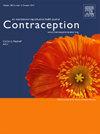左炔诺孕酮 52 毫克宫内节育器的无声放置:可行性研究
IF 2.8
2区 医学
Q1 OBSTETRICS & GYNECOLOGY
引用次数: 0
摘要
方法在这项分三个阶段进行的可行性研究中,第一阶段的参与者在放置宫内节育器前进行了子宫探查。在实验阶段,放置宫内节育器时不进行探查,同时进行(第二阶段)或不进行(第三阶段)经腹超声检查。我们对从宫颈探音(第一阶段)或宫内节育器置入器(第二/三阶段)接触宫颈到完全取出置入器的过程进行了计时。医生酌情使用宫颈麻醉。参与者使用 100 毫米视觉模拟量表对疼痛进行评分。医生将手术分为简单、中等和困难三个等级。第二和第三阶段的参与者接受了为期三个月的超声波随访。我们估计每个阶段需要 30 名参与者,以确保即使出现一次置管失败,成功置管的 95% 置信区间下限也将≥90%。第二阶段有 30 人(100%)成功置管,第三阶段有 28 人(93.3%)成功置管。中位器械置入时间更短(79.7 秒 vs 23.3 秒 vs 42.4 秒;P=0.04),无探头。第一阶段的疼痛中位数最低(21.0 vs 25.5,vs 36.0;P=0.04)。与第一阶段(22 人,73.3%)或第三阶段(22 人,73.3%;P=0.03)相比,第二阶段(29 人,96.7%)医生最常将宫内节育器放置简单化。并发症包括第三阶段的一次穿孔和一次脱出。无探头放置可缩短器械植入时间,但不会减少疼痛。有必要进行大规模研究,以评估不探查和不使用超声波检查时的并发症发生率。本文章由计算机程序翻译,如有差异,请以英文原文为准。
LEVONORGESTREL 52 MG INTRAUTERINE DEVICE PLACEMENT WITHOUT SOUNDING: A FEASIBILITY STUDY
Objectives
We aimed to evaluate feasibility of levonorgestrel 52 mg intrauterine device (IUD) placement without sounding.
Methods
In this three-phase feasibility study, participants in phase one had uterine sounding prior to IUD placement. In the experimental phases, placement occurred without sounding and with (phase two) or without (phase three) concurrent transabdominal sonography. We timed procedure length from the sound (phase one) or IUD inserter (phases two/three) touching the cervix to full inserter removal. Providers used cervical anesthesia per their discretion. Participants rated pain using a 100 mm Visual Analogue Scale. Physicians described procedures as easy, moderate, or difficult. Participants in phases two and three had three-month follow-up with ultrasonography. We estimated 30 participants per phase were needed to ensure that if one failed placement occurred, the lower 95% confidence interval for successful placement would be ≥90%.
Results
We enrolled 30 participants per phase. Successful placement without sounding occurred in 30 (100%) participants in phase two and 28 (93.3%) in phase three. Median instrumentation was shorter without sounding (79.7 vs 23.3 vs 42.4 seconds; p=0.04). Median pain was lowest in phase one (21.0 vs 25.5, vs 36.0; p=0.04). Physicians rated IUD placement easy most often in phase two (n=29, 96.7%) compared to phases one (n=22, 73.3%) or three (n=22, 73.3%; p=0.03). Complications included one perforation and one expulsion in phase three.
Conclusions
IUD placement without sounding is feasible with concurrent transabdominal sonography. Placement without sounding results in shorter instrumentation time but does not decrease pain. Large studies are indicated to evaluate complication rates when no sound and no ultrasonography is used.
求助全文
通过发布文献求助,成功后即可免费获取论文全文。
去求助
来源期刊

Contraception
医学-妇产科学
CiteScore
4.70
自引率
17.20%
发文量
211
审稿时长
69 days
期刊介绍:
Contraception has an open access mirror journal Contraception: X, sharing the same aims and scope, editorial team, submission system and rigorous peer review.
The journal Contraception wishes to advance reproductive health through the rapid publication of the best and most interesting new scholarship regarding contraception and related fields such as abortion. The journal welcomes manuscripts from investigators working in the laboratory, clinical and social sciences, as well as public health and health professions education.
 求助内容:
求助内容: 应助结果提醒方式:
应助结果提醒方式:


